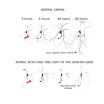(Press-News.org) NORMAN, Okla. – A new discovery by University of Oklahoma and North Carolina State University researchers shows a breakthrough in speeding up the process for synthesizing transition metal oxide nanostructures. What had once taken days can now be accomplished instantaneously.
After previous success using an oxygen-enriched flame to synthesize common nanomaterials, such as carbon nanotubes, nanofibers and fullerenes, OU College of Engineering professor Wilson Merchán-Merchán and his team conducted experiments using the same method to create a new form of nanostructures. Instead of synthesizing the carbon nanomaterials, they discovered a method of creating 1-D and 3-D TMOs that have distinctive electronic and mechanical properties.
With a multi-year grant from the National Science Foundation, Merchán-Merchán and his research affiliates are exposing bulk transition metals to the hottest parts of an oxygen-enriched flame. From that reaction, high-demand transition metal-oxide nanostructures are instantaneously synthesized, including nanorods, hollow channels and hybrid nanowires and platelets.
Inexpensive and quick growth of TMOs means a better chance for large-scale synthesis and eventual common use in the marketplace. The potential for increased supply has led to increased experimentation on the capacity of TMOs, and the results show their effectiveness in a diverse range of applications.
"Recently, one-dimensional TMO naonostructures have attracted tremendous attention due to their applications in optics, medicine and electronics," Merchán-Merchán said. "For instance, the micron-sized channel structures with nanometer wall thickness contain slender, prismatic and completely hollow cavities that can be used in medical applications for drug delivery."
Most recently, this research team coated the surface of solar panels with one of their flame-formed tungsten oxide nanorods. The result was a 5 percent increase in the solar panel's efficiency, a large gain considering solar panels' notoriously low efficiency rating of 15 to 20 percent.
With endless applications and a new horizon of possibilities, Merchán-Merchán's research into TMOs is still in its infancy.
"The distinct shape and chemical composition of the flame-formed nanostructures may change the way many products are designed," Merchán-Merchán said.
"Our next steps are to expand the application of TMOs using flames, in a variety of markets ranging from solar panels to electrodes for penetrating biological tissues for drug delivery and electrodes in lithium-ion batteries."
###
Merchán-Merchán said in order to scale-up the process, which is necessary for commercialization, an industrial partnership is essential.
In addition to Merchán-Merchán, the OU research team includes doctoral student Moien Farmahini as well as North Carolina State University researcher and professor Alexei Saveliev and doctoral student Shubham Srivastava.
Photo cutlines
Photo KP2-2262: (Left) Moien Farmahini, a Ph.D. candidate in mechanical engineering, runs experiments with mechanical engineering professor Wilson Merchán-Merchán in the lab on the University of Oklahoma Norman campus.
Photo KP2-2241: Moien Farmahini exposes a transition metal to a flame to rapidly create transition metal oxides.
More photos available upon request. Contact Mindy Rule at mrule@anglinpr.com.
New discovery shows promise in future speed of synthesizing high-demand nanomaterials
2012-11-01
ELSE PRESS RELEASES FROM THIS DATE:
Study finds that adding soy to the diet does not affect onset of menopausal hot flashes
2012-11-01
(SACRAMENTO, Calif.) — A team of investigators led by UC Davis found that eating soy products such as soy milk and tofu did not prevent the onset of hot flashes and night sweats as women entered menopause.
Unlike previous studies investigating the relationship between soy and these menopausal symptoms, the current study included a very large population over a long period of time: more than 1,600 women over 10 years.
The article, titled "Phytoestrogen and Fiber Intakes in Relation to Incident Vasomotor Symptoms: Results from the Study of Women's Health Across the Nation," ...
Gene required for nerve regeneration identified
2012-11-01
A gene that is associated with regeneration of injured nerve cells has been identified by scientists at Penn State University and Duke University. The team, led by Melissa Rolls, an assistant professor of biochemistry and molecular biology at Penn State, has found that a mutation in a single gene can entirely shut down the process by which axons -- the parts of the nerve cell that are responsible for sending signals to other cells -- regrow themselves after being cut or damaged. "We are hopeful that this discovery will open the door to new research related to spinal-cord ...
A glimpse into neurosurgical risk prevention and the surgical checklist
2012-11-01
Charlottesville, VA (November 1, 2012). The November issue of Neurosurgical Focus is dedicated to lessening the number and severity of adverse events surrounding neurosurgical intervention for a variety of disorders. Guest editors Alexander Khalessi (University of California, San Diego), James Forrest Calland (University of Virginia), Gabriel Zada (University of Southern California), and Michael Y. Wang (University of Miami Health System) selected 16 articles on systems-based quality improvement for neurosurgical procedures.
The articles are divided into four major subtopics: ...
An elephant that speaks Korean
2012-11-01
An Asian elephant named Koshik can imitate human speech, speaking words in Korean that can be readily understood by those who know the language. The elephant accomplishes this in a most unusual way: he vocalizes with his trunk in his mouth.
The elephant's vocabulary consists of exactly five words, researchers report on November 1 in Current Biology, a Cell Press publication. Those include "annyong" ("hello"), "anja" ("sit down"), "aniya" ("no"), "nuo" ("lie down"), and "choah" ("good"). Ultimately, Koshik's language skills may provide important insights into the biology ...
JCI early table of contents for Nov. 1, 2012
2012-11-01
Congenital diarrheal disorder linked to a mutation in DGAT1
Congenital diarrheal disorders (CDD) are a group of rare intestinal diseases that are caused by genetic mutations. In a study published in the Journal of Clinical Investigation, Robert Farese and colleagues at the University of California, San Francisco, identified a family with two of three children affected by CDD. The affected children both carried a rare mutation in the DGAT1 gene. DGAT1 mediates the formation of triglycerides and is being assessed as a therapeutic target in the treatment of obesity. The study ...
Congenital diarrheal disorder linked to a mutation in DGAT1
2012-11-01
Congenital diarrheal disorders (CDD) are a group of rare intestinal diseases that are caused by genetic mutations. In a study published in the Journal of Clinical Investigation, Robert Farese and colleagues at the University of California, San Francisco, identified a family with two of three children affected by CDD. The affected children both carried a rare mutation in the DGAT1 gene. DGAT1 mediates the formation of triglycerides and is being assessed as a therapeutic target in the treatment of obesity. The study by Farese's group suggests that targeting of DGAT1 could ...
Feedback loop maintains basal cell population
2012-11-01
HOUSTON - (Nov. 2, 2012) – Notch – the protein that can help determine cell fate – maintains a stable population of basal cells in the prostate through a positive feedback loop system with another key protein – TGF beta (transforming growth factor beta), said Baylor College of Medicine researchers in the journal Cell Stem Cell.
"When basal cell homeostasis (or maintenance of a stable population) is disrupted, it may be part of the process that initiates prostate cancer," said Dr. Li Xin, assistant professor of molecular and cellular biology at BCM and a senior author ...
Rice team boosts silicon-based batteries
2012-11-01
HOUSTON – (Nov. 1, 2012) – Researchers at Rice University have refined silicon-based lithium-ion technology by literally crushing their previous work to make a high-capacity, long-lived and low-cost anode material with serious commercial potential for rechargeable lithium batteries.
The team led by Rice engineer Sibani Lisa Biswal and research scientist Madhuri Thakur reported in Nature's open access journal Scientific Reports on the creation of a silicon-based anode, the negative electrode of a battery, that easily achieves 600 charge-discharge cycles at 1,000 milliamp ...
Stem cells show promise for treating infertility in cancer patients
2012-11-01
AUDIO:
This is an audio clip of Deborah Sweet of Cell Stem Cell interviewing Dr. Kyle Orwig of the University of Pittsburgh School of Medicine regarding his recent preclinical study "Spermatogonial...
Click here for more information.
A promising stem-cell-based approach for treating infertility has been successfully demonstrated in non-human primates, as reported in a study published by Cell Press in the November issue of the journal Cell Stem Cell. The preclinical study ...
Meth vaccine shows promising results in early tests
2012-11-01
LA JOLLA, CA – Scientists at The Scripps Research Institute (TSRI) have performed successful tests of an experimental methamphetamine vaccine on rats. Vaccinated animals that received the drug were largely protected from typical signs of meth intoxication. If the vaccine proves effective in humans too, it could become the first specific treatment for meth addiction, which is estimated to affect 25 million people worldwide.
"This is an early-stage study, but its results are comparable to those for other drug vaccines that have then gone to clinical trials," said Michael ...


